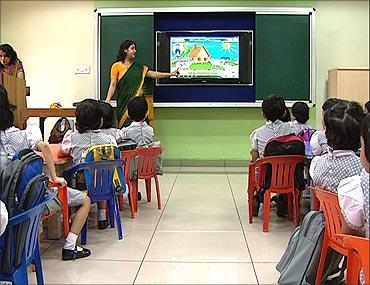 | « Back to article | Print this article |
Digital classrooms open a new chapter in schools
With the foray of private players like Tata Interactive Systems and Birla Shloka Edutech, the market for digital classrooms is expected to grow at 25 per cent in 2012.
Rakesh Mishra, a 13-year-old student in Bherunda village of Rajasthan's Nagaur district, is learning how the dissection of a toad's heart is done.
But his hands are not messy, nor does he feel disgusted watching the procedure. He is watching the entire process on a screen in a digital classroom in his school. Rakesh may be disappointed that he belongs to a less known village, but is delighted that he can avail of ICT-enabled solutions in his village classroom, similar to his urban peers.
Digital classroom service providers, including Educomp Solutions, Pearson Education Service, Tata Interactive Systems and Birla Shloka Edutech, have forayed into the non-metro regions to provide such services.
"We have customers across Tier-I and -II cities, as well as smaller towns. Schools, big or small, have realised the potential of getting multimedia-based content to support teaching in the classroom," said Meena Ganesh, MD and CEO, Pearson Education Service.
Ganesh said since her company offered solutions to schools on a build-operate-transfer mode, the service is affordable. Schools acquire the solution on a monthly-payment basis over three or five years. This typically is in the range of Rs 100 to 150 per student per month.
The total market size for digital classrooms was estimated at Rs 3,000 crore in 2011, and it is expected to grow at 25 per cent this year, according to Abhinav Dhar, director-K12, Educomp Solutions. He said there was potential for digitising 800,000 classrooms in the smaller towns. This is not restricted to private schools; Smartclass pilots are underway in some government schools as well.
Educomp's Smartclass, the digital classroom solution, has been adopted by 10,000 schools across cities, small towns and rural areas spread across 560 districts in the country. Besides metros, large cities and towns, Smartclass is also present in schools at little-known places like Bherunda (Rajasthan), Barot (Himachal Pradesh) and Samba (Jammu & Kashmir) among others. Today, 70 per cent of Smartclass adoptions are taking place in schools in Tier-II, -III and -IV cities, as well as in rural areas, said Dhar.
The child-centric concept in classrooms is what prompted the schools to adopt this technology. believes N Srikrishna, managing director, Birla Shloka Edutech. The company, which offered ICT solutions to 542 tribal schools across Maharashtra and is present in 200 private schools in the state, is now looking to expand in Gujarat, Tamil Nadu, Andhra Pradesh and Puducherry. The company gets 40 per cent revenue from technology solutions.
Birla Shloka Edutech is planning to build 100 schools across India that will be enabled with digital classrooms. Srikrishna says to make the solutions affordable.
The company has two different school solutions -- 'Open-Mind' schools for the budget category and the 'Shloka' schools for the affluent category.
The potential of the market is so high that even big corporate players like TIS are aiming for wide reach. Rajesh Shethia, head, sales and marketing, schools division at TIS, explains that they are looking to extend the solutions to each and every district in the coming years. They have even started getting 50 per cent revenue from tier III and IV regions.
"It is a logical step. Availability of decent teachers in smaller towns has always been an issue. Therefore, it makes sense for teachers and parents to go for these solutions, instead of shifting the child to a larger town for education," he explained. The content offered is customised as per the requirement of the schools.
On an average, the cost per classroom is Rs 5,000 per month; and if the whole school is digitised, the cost may be about Rs 1 crore. Players see smaller towns going in for overall digitisation, rather than digitisation of a single classroom. "This is in spite of the fact that the cost for solutions in small towns and big cities is the same," said Shethia.
Challenges are there in these markets, said industry players. Internet connectivity to enable cloud solutions has been a major challenge, according to Shethia of TIS. Getting the infrastructure down to these areas is another challenge, cited by the players. However, the acceptance of the solutions overshadows the challenges.
"Three years back, schools in smaller towns were averse to the whole concept. Now, at least they are open to it," said Shethia.
"There are close to 15 lakh government and one lakh private schools in the country. Only 7-10 per cent of the private schools have tapped the potential of multimedia classroom teaching, whereas in government schools, it has barely made any inroads," says Dhar.

